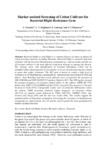Use este identificador para citar ou linkar para este item:
http://www.alice.cnptia.embrapa.br/alice/handle/doc/1041528Registro completo de metadados
| Campo DC | Valor | Idioma |
|---|---|---|
| dc.contributor.author | FAUSTINE, C. | pt_BR |
| dc.contributor.author | HOFFMANN, L. V. | pt_BR |
| dc.contributor.author | LUKONGE, E. | pt_BR |
| dc.contributor.author | TIBAZARWA, F. I. | pt_BR |
| dc.date.accessioned | 2016-03-21T11:11:11Z | pt_BR |
| dc.date.available | 2016-03-21T11:11:11Z | pt_BR |
| dc.date.created | 2016-03-21 | pt_BR |
| dc.date.issued | 2015 | pt_BR |
| dc.identifier.citation | HURIA Journal of The Open University of Tanzania, Dar es Salaam, v. 19., n. 1, P. 1-7, Feb. 2015. | pt_BR |
| dc.identifier.issn | 0856-6739 | pt_BR |
| dc.identifier.uri | http://www.alice.cnptia.embrapa.br/alice/handle/doc/1041528 | pt_BR |
| dc.description | Bacterial blight or leaf blight is a common disease of cotton in almost all cotton growing countries, including Tanzania. Bacterial blight is caused by infection of plants with the bacteria (Xanthomonas axonopodis pv. malvacearum) and the use of resistant cultivars is the most effective long-term strategy to manage the disease. The strategy starts with identification of resistant individuals, which can be identified either phenotypically by inoculation or by use of molecular markers linked to genes that confer resistance. The B12 gene is known to confer a high level of resistance to all Xanthomonas axonopodis pv. malvacearum races found in USA and Africa. Four Brazilian and three local cultivars were screened for the presence of SSR (CIR246) and SNP NG0207155 markers linked to B12. The SNP marker showed the greatest frequency of resistance-linked alleles in the cultivar UK08 (85.71%) followed by UK91 (75%),UKM08 and Ipê (25%), Araça(8.33%),Aroeira (7.1%) and the least in Cedro (0%). Comparable results were recorded for SSR marker where the cultivar UK08 presented relatively higher frequency of resistance alleles (85.71%) of samples tested followed by UK91 (68.75%), UKM08 (25%), Ipê, Aroeira and Araça (8%) and the last was Cedro (0%). The results suggest the potential utility of Tanzanian germplasm in breeding for resistance to Xanthomonas axonopodis pv. malvacearum race 18 and the need to purify the same germplasm by marker assisted selection. | pt_BR |
| dc.language.iso | eng | eng |
| dc.rights | openAccess | eng |
| dc.subject | Bacterial blight | pt_BR |
| dc.subject | Xanthomonas axonopodis pv malvacearum | pt_BR |
| dc.subject | Molecular marker | pt_BR |
| dc.title | Marker-assited screening of cotton cultivars for bacterial blight resistance gene. | pt_BR |
| dc.type | Artigo de periódico | pt_BR |
| dc.date.updated | 2016-03-24T11:11:11Z | pt_BR |
| dc.subject.thesagro | Gene | pt_BR |
| dc.subject.thesagro | Bactéria | pt_BR |
| dc.subject.thesagro | Algodão | pt_BR |
| dc.subject.thesagro | Germoplasma | pt_BR |
| dc.subject.nalthesaurus | cotton | pt_BR |
| riaa.ainfo.id | 1041528 | pt_BR |
| riaa.ainfo.lastupdate | 2016-03-24 | pt_BR |
| dc.contributor.institution | CHRISTOPHER FAUSTINE, THE OPEN UNIVERSITY OF TANZANIA; LUCIA VIEIRA HOFFMANN, CNPA; EVERINA LUKONGE, UKIRIGURU AGRICULTURAL RESEARCH INSTITUTE; FLORA ISMAIL TIBAZARWA, UNIVERSITY OF DAR ES SALAAM - TANZANIA. | pt_BR |
| Aparece nas coleções: | Artigo em periódico indexado (CNPA)  | |
Arquivos associados a este item:
| Arquivo | Descrição | Tamanho | Formato | |
|---|---|---|---|---|
| Markerassistedscreeningofcottoncultivars....pdf | 90,13 kB | Adobe PDF |  Visualizar/Abrir |









